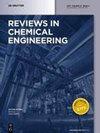用微流控芯片制备单分散液滴和微胶囊:方法和应用综述
IF 6.6
3区 工程技术
Q1 ENGINEERING, CHEMICAL
引用次数: 0
摘要
摘要微流控技术因其高封装效率、制备均匀粒径、控制核壳比和结构的能力,已被广泛应用于单分散液滴和微胶囊的制备。本文综述了微流控芯片的设计、结构、材料和表面改性技术,介绍了微流控芯片在单分散微胶囊制备和应用方面的研究进展。综述了各种微流控装置制备单、多单分散乳化液液滴的制备方法、运行参数和调节方法。结果表明,单分散液滴粒径主要取决于微通道特征尺寸和流量,微通道越大,粒径越大,连续相流速率越高,粒径越小。对单分散微胶囊的制备方法进行了综述和比较,包括界面聚合、自由基聚合、离子交联和溶剂蒸发等。综述了单分散微胶囊在生物、食品、复合材料和制药等领域的应用。研究发现,利用高通量微流体技术规模化制备单分散微胶囊,实现单分散微胶囊的均匀降解和靶向释放特性将是未来应用的关键创新方向。本文章由计算机程序翻译,如有差异,请以英文原文为准。
Fabrication of monodisperse droplets and microcapsules using microfluidic chips: a review of methodologies and applications
Abstract Microfluidics has been applied in the preparation of monodisperse droplets and microcapsules due to its high encapsulation efficiency, its ability to create uniform particle sizes, and its capacity to control core–shell ratio and structure. To bring to the fore methodologies for the fabrication and application of monodisperse microcapsules using microfluidics, we present a review of the design, structure, materials, and surface modification techniques of various microfluidic chips. The review also covers fabrication methods, operating parameters and regulation methods of single and multiple monodisperse emulsion droplets fabricated from various microfluidic devices. Our findings show that particle size of monodisperse droplets depend mainly on microchannel characteristic size and flow rate, with particle size increasing with larger microchannel but decreasing with higher continuous phase flow rate. We additionally reviewed and compared various fabrication methods for monodisperse microcapsules, such as interfacial polymerization, free-radical polymerization, ionic cross-linking, and solvent evaporation. We further reviewed and examined the application of monodisperse microcapsules in biology applications, food engineering, composite materials development, and pharmaceutical industry. We found that high-throughput microfluidics for scale-up monodisperse microcapsule preparation towards uniform degradation and targeted release properties of monodisperse microcapsules would be key innovative direction for future applications.
求助全文
通过发布文献求助,成功后即可免费获取论文全文。
去求助
来源期刊

Reviews in Chemical Engineering
工程技术-工程:化工
CiteScore
12.30
自引率
0.00%
发文量
37
审稿时长
6 months
期刊介绍:
Reviews in Chemical Engineering publishes authoritative review articles on all aspects of the broad field of chemical engineering and applied chemistry. Its aim is to develop new insights and understanding and to promote interest and research activity in chemical engineering, as well as the application of new developments in these areas. The bimonthly journal publishes peer-reviewed articles by leading chemical engineers, applied scientists and mathematicians. The broad interest today in solutions through chemistry to some of the world’s most challenging problems ensures that Reviews in Chemical Engineering will play a significant role in the growth of the field as a whole.
 求助内容:
求助内容: 应助结果提醒方式:
应助结果提醒方式:


